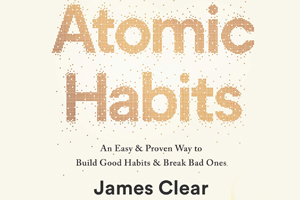James Clear’s book Atomic Habits states that big goals should not be the main focus of peoples’ lives. It encourages readers to utilize frequent and repetitive actions and systems to help form invaluable habits that last life-long. The overriding theme of Atomic Habits is the concept that even one minor change, practiced daily, can lead to drastic changes in peoples’ lifestyles. He maintains that the quality of an individual’s life depends on the quality of the habits they practice. While some habits may be as minuscule as an atom, the accumulation of these atomic habits can create a significant impact on individuals’ lives.
Key Takeaways
- Habits are like trees with strong roots. Uprooting a bad habit is as difficult as making a good habit take root.
- Breaking a bad habit is a tough ask and the best way to do so is to limit exposure to the cues that trigger it.
- Inversely, building a good habit is more about the environment individuals are in, than the motivation. If the environment is not conducive to the habit, motivation can only go so far.
- It is more important to repeat a habit than to perfect it. Perfection comes with the number of repetitions being undertaken.
- Devising rewards for sticking to even the smallest of habits makes the process more enjoyable and fulfilling.
- Habit stacking, which refers to a sequence of good habits that take place one after the other, is a good way to create a lifestyle system. The practice helps develop a routine of good habits aimed at attaining the ideal lifestyle.
- Habit trackers, both human and app-based, help individuals stick to the good habit for a longer duration.
Habit and its impact on quality of life
Like a tree, every big thing is created through a small beginning and therefore, tiny, atomic things can also make a major difference. Every habit is seeded from a single, minuscule decision and, when that decision is repeated over a period of time, the habit sprouts and gains strength. Akin to a tree, the habit forms roots and entrenches itself in the psyche of the individual, allowing branches to grow. Given the deep roots that consistent repetitions have, it is extremely difficult to uproot a bad habit – almost as difficult as uprooting a powerful oak growing within the minds of people. Similarly, the task of building a good habit is as laborious as cultivating a delicate bloom, which requires daily attention.
While habits are minor, daily behavioral traits that people practice automatically, they are also extremely powerful. People become what they do every day. This means that habits form peoples’ identities. When repeated consistently, even the minutest of actions end up having a massive impact. While the impact can be significant, building and maintaining good habits requires immense patience and individuals must understand that while changes may not be visible right away, good habits do keep them on the trajectory towards an optimal lifestyle system. Even minor alterations in behavior and practices, when practiced long enough, can have a significant effect on a person’s future.
Difficulties in building good habits
There are several elements that combine to create a habit, and foremost among them is conditioning. People usually repeat satisfying actions and behaviors till they become automatic and one of the most basic examples of this fact is the common habit of thumb-sucking seen in babies. Thumb sucking has a calming effect on babies, and they resort to it in stressful situations. The action creates a satisfactorily calming effect on their psyche, and it triggers them to repeat the behavior during future incidents which they perceive as stressful, making it a habit which could last well into their school days, if not broken in good time. This is called conditioning, and as with bad habits, it can also be used to develop good habits. For instance, a trip to the gym releases endorphins in individuals, which can trigger them to continue with the practice and foster a healthy lifestyle.
Indeed, even minor improvements can lead to a change in lifestyle, as the benefits from these small habits can accumulate over the course of time, especially when these habits are repeated daily. It is important to note that even a 1% improvement each day can lead to a 37% improvement over the period of a year, indicating the impact of atomic habits in attaining individual goals. Atomic habits have a compounding effect on people – money deposited in an account accrues compound interest during the period of investment and similarly, atomic habits compound into self-improvement. In line with this concept, individuals must understand that this compounding may not be visible from the get-go, it will take consistent effort and time for the impact to show. Thus, it is imperative that people should not give up on their good habits because of the absence of results in the initial stages. The goal should be to develop compound interest in healthy habits while mitigating the impact of bad habits which could compound into toxic outcomes.
Concentrating on systems instead of goals
People need to be more concerned with their current trajectories than the current results. Therefore, focusing on the systemic process is more important than worrying about the goal which may appear unattainable at the outset. Indeed, maintaining focus on the system and working consistently to better it will ensure that people reach their goals at the end of the road. Both winners and losers might start out with the same goals, but success lies in attaining the goal. Indeed, attaining a goal is a momentary alteration in peoples’ life, and it could end up limiting their happiness. The goal-oriented approach usually sets people up for failure, but a lifestyle-system oriented approach ensures lasting satisfaction and happiness as people look for pleasure in the process, rather than in the end goal. Changing bad habits also require people to focus on the system they are embracing. People do not rise to the level of their goals, rather, they fall to the level of the system they follow.
Optimizing habit loops
Habits come in loops – they are self-reinforcing. Performing an action, and receiving the inherent reward, ensures that people will return to the same action time and again, creating a habit loop. The loop consists of the following steps – a cue prompts individuals’ brains to perform an action because it predicts a reward, the reward leads to future cravings, and this craving pushes them to repeat the action multiple times, forming a habit and a part of their identities. This process can also be explained through a neurological feedback loop, which consists of cue –> craving –> response –> reward. Going ahead, this habit loop begins to deliver long-term results. This concept can be leveraged to change a bad habit or form a good one. The more frequently people practice this habit loop with good habits, the more it will transition into an automatic occurrence, building the base for a positive lifestyle system.
Laws for building good habits
People shouldtake advantage of habit loopsby making the invisible cues obvious. This can help with both, building good habits and removing bad habits. For instance, if a person wishes to learn the guitar, they require obvious cues to remind them to keep practicing. This can be done by putting the guitar in an easily visible and accessible spot like the middle of the living room. Such an action triggers the brain to pick it up and practice more often.
Habit stacks, which refers to the act of adding habits before and after a particular habit, can also help introduce new cues into peoples’ lifestyles. The brain is capable of creating strong neurological connections to bolster regular habits and these connections can be harnessed to tie a new habit to an already established one, making the process easier to repeat on a daily basis. For instance, if people wish to make meditation a habit, they can tie it to the habit of drinking coffee in the morning. This will prompt them to get into the meditation mindset as soon as they get done with drinking coffee, which is a pre-established daily habit.
Building good habits can also be amatter of pride– the more pride a person feels in a particular facet of their identity, the more motivation they will feel in maintaining the habits associated with that aspect. For instance, if a person is proud of their physical appearance, they will be more motivated to make fitness training a habit. Environmental stimuli can also trigger habitual actions, and this can be used to cultivate good habits. Changing the environment while creating obvious cues can make it easier to develop a good habit.
Additionally,implementation intentions, or specific plans related to the time and place where the new habit is performed, can also aid the development of said habits. For example, a person can create a clear plan of action towards practicing a good habit, instead of merely saying that they will do it at an unspecified time or place.
Creating small rewardsfor following habits can also help develop a fulfilling lifestyle system. People find motivation in the anticipation of a reward as the brain releases dopamine, or the feel-good chemical, both while doing pleasurable things and while anticipating them. People should link the habits they wish to form, which may not appear rewarding at the outset, with a behavior they find attractive. This can include watching their favorite series while they cycle at home or at the gym, making the habit of cycling more attractive.
Aloyalty system, wherein people complement the practice of a good habit with a satisfying reward, is also an effective method. For instance, if a person loves to travel and is attempting to give up alcohol, they can make small contributions to their travel account for each week that they stay off the bottle.
It is also important to make the habiteasily adoptable. People should reduce the friction for good habits while increasing it for bad habits. For the same, the two-minute rule, which breaks down the new habit into manageable two-minute bites, can help tremendously as getting started is the most important step towards developing a habit, and in turn, a better lifestyle system.
Joining a culture where the desired habit is considered normal, is another good way of sticking to the routine. For instance, people can join a book club if they wish to inculcate the habit of daily reading. The same is relevant while breaking bad habits – people must remove themselves from a culture that normalizes the bad habit if they wish to exterminate it from their lives.
Tracking good habits
Maintaining a good habit can be difficult in the long run, and habit trackers can help overcome this obstacle. They ensure that people maintain the daily actions necessary to feed a habit. Habit tracking induces satisfaction as it indicates the progress people make, thus ensuring that the practice becomes a habit. Another option is to create a habit contract which inflicts negative consequences if the person veers off track. In this option, it is better to involve other people as knowing that someone is keeping an eye on the progress ensures that people stick to their habits.
Layers of behavior change
Behavior change consists of three layers – outcomes, processes, and identity. Outcome is the outer layer, which comprises the results of a habit. Process defines the actions people follow to achieve the results, and identity, the innermost layer, indicates the beliefs people hold. It is imperative to change the underlying identity, which leads to negative habits, to create good habits. Indeed, every action is a vote towards the type of identity a person wishes to create. While no singular action can transform beliefs overnight, the new identity develops in tandem with continued positive actions. A simple two-step process to trigger long-term change includes being the type of person that an individual wants to be and proving this identity through small wins and tiny atomic habits that go towards building the optimal personality.
Inculcating atomic habits in your financial planning can potentially lead to a very satisfying and positive financial journey. Just like small changes in life can create a big impact, similarly small investments in mutual funds can compound over time to create a big impact. You can invest in a mutual fund scheme of your choice through a systematic investment plan (SIP). This entails investing small or large amounts of money, consistently over a period of time. You can invest fortnightly, monthly or even quarterly. The important thing is that you continue investing. Another thing to understand is the importance of discipline and accepting that the true benefits can only accrue over the long-term. While small changes can make a big impact, the impact only happens if you consistently stick to these changed habits over a period of time. You should expect the same from your investments as well. Instead of expecting immediate returns, you must stay invested for the long-term to reap the benefits of your mutual fund investments.
An investor education initiative
All Mutual Fund Investors have to go through a onetime KYC process. Investor should deal only with Registered Mutual Fund (RMF). For more info on KYC, RMF and procedure to lodge/redress any complaints – please visit onhttps://www.edelweissmf.com/kyc-norms
MUTUAL FUND INVESTMENTS ARE SUBJECT TO MARKET RISKS, READ ALL SCHEME RELATED DOCUMENTS CAREFULLY.
Trending Books
MUTUAL FUND INVESTMENTS ARE SUBJECT TO MARKET RISKS, READ ALL SCHEME RELATED DOCUMENTS CAREFULLY.













